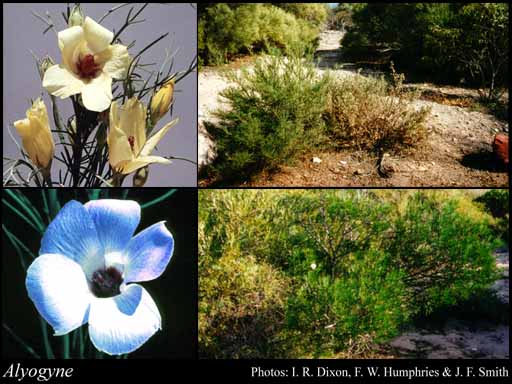- Reference
- Oesterr.Bot.Z. 13:12 (1863)
- Name Status
- Current







Scientific Description
Common name. Native Hibiscuses. Family Malvaceae.
Tribe Hisbisceae.
Habit and leaf form. Shrubs (with a sparse to dense indumentum). Plants unarmed. To 1–3 m high. Mesophytic. Not heterophyllous. Leaves small to medium-sized; alternate; spiral; petiolate; non-sheathing; simple. Leaf blades dorsiventral; dissected (3–5-lobed), or entire; ovate, or obovate; palmately lobed, or much-divided; pinnately veined; cross-venulate; rounded at the base. Mature leaf blades adaxially glabrous, or pubescent; abaxially glabrous, or pubescent. Leaves with stipules (stipules triangular). Stipules often caducous. Leaf blade margins crenate, or serrate. Leaf anatomy. Hairs present; complex hairs present. Complex hairs stellate. Extra-floral nectaries absent.
Reproductive type, pollination. Fertile flowers hermaphrodite. Unisexual flowers absent. Plants hermaphrodite. Entomophilous.
Inflorescence and flower features. Flowers solitary; axillary; pedicellate (pedicels articulate); large; regular; 5 merous; tetracyclic. Hypogynous disk absent. Perianth with distinct calyx and corolla; 10; 2 -whorled; isomerous. Calyx present (semi-stipitate); 5; 1 -whorled; gamosepalous; lobed; lobulate (5-lobed); hairy; valvate; exceeded by the corolla; campanulate; regular; persistent. Calyx lobes triangular. Epicalyx present (of linear to subulate basally connate bracteoles). Corolla present; 5; 1 -whorled; polypetalous (adnate to the base of the staminal column); hairy abaxially; hairy adaxially, or glabrous adaxially; with contrasting markings (darker colour at base); red, or pink, or purple, or violet, or white (rarely). Petals obovate. Androecium present. Androecial members indefinite in number. Androecium 50–100 (i.e. ‘many’). Androecial members adnate; all equal; coherent (connate; the filaments fused in a column surrounding the style); 1 - adelphous (the tube attached to the petals); 1 -whorled. Androecium exclusively of fertile stamens (or rather, half-stamens, each having only a half anther). Stamens 50–100. Anthers dehiscing via longitudinal slits; introrse; unilocular. Gynoecium 3–5 carpelled (in a single whorl). The pistil 3–5 celled. Gynoecium syncarpous; synstylovarious to eu-syncarpous; superior. Ovary plurilocular; 3–5 locular. Gynoecium stylate. Styles 1; simple; apical. Stigmas 5 (sub-sessile); clavate. Placentation axile. Ovules 3–10 per locule (i.e. 3-many).
Fruit and seed features. Fruit 10–12 mm long; non-fleshy; dehiscent; a capsule (ellipsoid). Capsules loculicidal (dehiscing by 3–5 valves). Dispersal unit the seed. Fruit 3–50 seeded (i.e. ‘many’). Seeds endospermic (copious); not compressed (reniform to globular); small; conspicuously hairy, or not conspicuously hairy.
Geography, cytology, number of species. World distribution: Australia. Native of Australia. Endemic to Australia. Australian states and territories: Western Australia, South Australia, Northern Territory, and Queensland. Northern Botanical Province and South-West Botanical Province. A genus of 4 species; 4 species in Western Australia; 0 endemic to Western Australia.
Etymology. After the Greek for "indissoluble" and "woman", referring to the joined (connate) style branches.
Taxonomic Literature
- Wheeler, Judy; Marchant, Neville; Lewington, Margaret; Graham, Lorraine 2002. Flora of the south west, Bunbury, Augusta, Denmark. Volume 2, dicotyledons. Australian Biological Resources Study.. Canberra..
- Grieve, B. J.; Blackall, W. E. 1998. How to know Western Australian wildflowers : a key to the flora of the extratropical regions of Western Australia. Part II, Dicotyledons (Amaranthaceae to Lythraceae). University of W.A. Press.. Nedlands, W.A..
- Wheeler, J. R.; Rye, B. L.; Koch, B. L.; Wilson, A. J. G.; Western Australian Herbarium 1992. Flora of the Kimberley region. Western Australian Herbarium.. Como, W.A..
- Marchant, N. G.; Wheeler, J. R.; Rye, B. L.; Bennett, E. M.; Lander, N. S.; Macfarlane, T. D.; Western Australian Herbarium 1987. Flora of the Perth region. Part one. Western Australian Herbarium.. [Perth]..